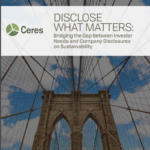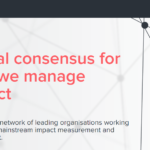The Global Reporting Initiative (GRI) provider of the worlds most widely used framework for disclosure on environmental, social and governance data (ESG) – today released a report examining how companies can frame their ESG disclosures to meet the needs of mainstream investors.
The report – Reaching Investors: communicating value through ESG disclosure was written following extensive consultation with the finance industry (1). It was launched by GRI at an event hosted by Bloomberg LP in New York City today.
Disclosure on economic, social and governance performance known as sustainability reporting – has become a mainstream business activity; the majority of Global Fortune 250 companies now issue such reports according to the recent International Survey of Corporate Responsibility Reporting from KPMG.
Investors have been a key driver in promoting the uptake of sustainability reporting – they are increasingly asking companies for ESG information to help them make investment decisions. Indeed, assets of over USD 15 trillion (estimated to be around 15% of total global capital markets) are now managed by signatories to the United Nations Principles for Responsible Investment (UNPRI). UNPRI signatories commit to integrating ESG issues into investment analysis and to seek appropriate disclosure on ESG issues by the entities in which they invest, by, for example, requesting ESG disclosure based on the GRI Reporting Framework (2) .
Sean Gilbert, Sustainability Reporting Framework Director at GRI said: As we can see from the number of investors now actively seeking ESG information in order to help them base investment decisions, the dichotomy between sustainability and long-term business value is false.
But, for ESG data to be useful to investors it must be presented in a consistent way, regardless of whether in the format of a combined sustainability and annual report or separate documents. Crucially, the link between a companys performance on environmental, social and governance issues and its business strategy must be made. Without this link investors will have no way to gage what the ESG disclosure might mean for the financial bottom line.
In addition to factoring in shareholders and stakeholders expectations of the companys sustainability performance, and linking ESG disclosure to business strategy the GRI report recommends the following for companies issuing sustainability reports:
Include supporting statements about ESG performance with facts and / or evidence
Contain forward looking contextual information
Be concise
Cover a balance of positive and negative sustainability performance
Relate ESG strategy to current opportunities and risks
Reporting should show how the companys behavior in a rapidly changing economic, environmental and social context is affecting its long-term value for example how the company is dealing with risks and opportunities presented by climate change or how it is addressing poverty and inequalities in the communities in which it operates and thus derives its workforce and consumers. In this context, business has to think differently and perform differently and, as weve seen, investors are increasingly seeking out ESG leaders. Sustainability reporting should help investors find those companies as well as help the companies understand how they themselves are positioned in the context of sustainability, added Gilbert.



